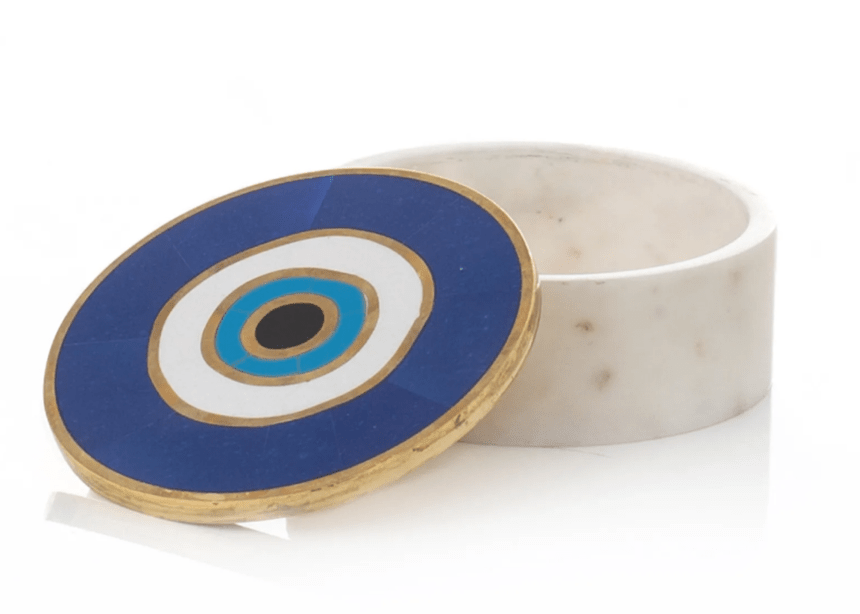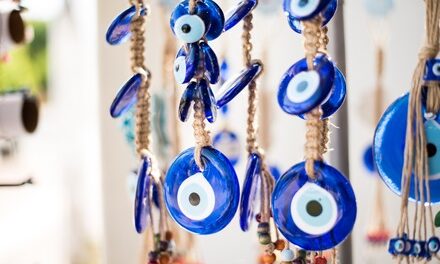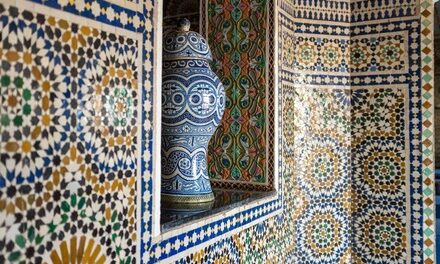
The evil eye––perhaps nothing conjures up more trouble and complication than a malevolent gaze. In short, envy. And what is envy but the desire to possess what others have? And the deeper truth: what one believes is lacking within the self or in one’s circumstances––whether it be a home, looks and beauty, youth, or certain charmed qualities: graciousness, an affable nature, or even a warm smile.
Deprivation then, and the desire to bring others down or even gain their wealth or circumstance, is what backs the evil eye.
Middle Eastern cultures have long been aware of the human desire to covet and possess. And whether intentionally or unintentionally cast, they believe that the evil eye has power to bring back luck to favorable circumstances.
Their solution? The nazar, also known as the evil eye amulet.
The Nazar’s Influence is Vast
The nazar––meaning ‘attention,’ “surveillance,’ or ‘sight’––is a striking blue eye-shaped amulet, often made from glass, that is believed to ward off and protect one from the evil eye. The design is usually of concentric circles done in shades of blue, white, and black.
The nazar’s presence and influence is vast––in Greece, it’s known as matiasma or mati. In Turkey, it’s known as the nazar boncuğu.
The mystical charm’s origins are rooted in ancient civilizations: Mesopotamia, Greece, and Rome. In those cultures, it was thought that the eye would either deflect or absorb harmful energies directed at the one’s self.
In ancient Greece and Rome, eye amulets were often worn as jewelry or carried as talismans to safeguard against envy. This tradition of protection has continued through the centuries and is deeply ingrained in the folklore of various cultures.

‘Mashallah’ –– the Evil Eye Antidote
The evil eye can be tricky––it’s commonly believed that it can be cloaked in the guise of a compliment. In Middle Eastern cultures, mothers who observe their children being lavishly complimented often neutralize the “jinx’ by saying massallah, “God has willed it.” It’s good protocol, in fact, to add the word when complimenting any child, especially in the presence of parents.
Today, the nazar is worn as jewelry, hung over doorways, displayed in automobiles, placed over cribs, used in tattoo designs––even dress patterns incorporate the symbol. The symbol has gained worldwide appeal. There’s even a nazar emoji, introduced in 2018, that’s become popular on social media posts. (Just type “nazar” or “evil eye” into your emoji search field on your cell phone to access it).
In recent decades, the nazar has evolved far beyond being used as just a decorative trinket. It’s also thought to attract positive energy, happiness, and good luck. It’s even used as a blessing for new beginnings such as births, weddings or a new home.
The Hamsa or Hand of Fatima
The nazar is often incorporated into the hamsa (also called the hand of Fatima, and the hand of Miriam): a decorative symbolic hand, which is also used in a protective manner by both Islamic and Jewish cultures.
“Hamsa” derives from the Arabic word for the number five, denoting the five fingers on a hand. It’s believed to originate in the Middle East and was used by the Carthaginians and Phoenicians.
In Islamic culture, the hamsa is referred to as the “Hand of Fatima” or “Khamsa”––named after Fatima, the daughter of the Prophet Muhammad. In this context, it symbolizes the Five Pillars of Islam and is also used as a protective amulet.
Among Jewish communities, the hamsa is called the “Hand of Miriam” or the “Hamesh Hand.” It is associated with the biblical Miriam, sister of Moses, and is believed to represent the protective and nurturing qualities of women.
Like the nazar, the hamsa can also be a symbol of blessing and good fortune, and moreover of unity given the hand’s structure that joins five fingers to serve beneficent purposes.

Christian Belief in the Evil Eye Amulet
In the late nineteenth and early twentieth century, Christian Syrian-Lebanese immigrates to America brought the influence of the amulet to America. Still, their influence in the charm was not widespread in the U.S., most likely because of strong needs and pressure to assimilate into their new culture.
This group’s belief in the evil eye shares many characteristics with other cultures. Their belief is also justified by various Bible passages. Oaths are sometimes invoked when the group uses the evil eye, as a way to fortify its power. An exorcism prayer has also been paired with the amulet’s use, which has been especially popular among emigrating Lebanese.

Use the Nazar and Hamsa to Ward of Your Own Envy
Having a few nazar and hamsa amulets around the house is an enjoyable way to participate and enjoy Middle Eastern culture. But perhaps the amulet’s true power is even deeper than how it’s been popularly considered.
In truth, the nazar and hamsa are excellent reminders to ward off one’s own envy and jealousy from the very moment we feel these emotions. Because in truth, we all feel them. Acknowledging them to one’s self is an essential first step to take before doing the deeper work of addressing what lies beneath envy and jealousy––which can include a sense of scarcity and deprivation, as well as a feeling of powerlessness.
After doing such deeper work, one’s envy can be released. The nazar and hamsa then becomes more than just a power object to keep one safe from the malevolent gaze of others. The amulets are transformed into a beautiful reminder of how essential it is to always clean one’s own house––first and foremost.





























